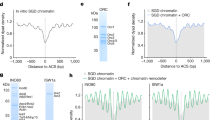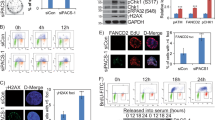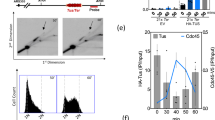Abstract
The mechanism by which the eukaryotic DNA-replication machinery penetrates condensed chromatin structures to replicate the underlying DNA is poorly understood. Here we provide evidence that an ACF1–ISWI chromatin-remodeling complex is required for replication through heterochromatin in mammalian cells. ACF1 (ATP-utilizing chromatin assembly and remodeling factor 1) and an ISWI isoform, SNF2H (sucrose nonfermenting-2 homolog), become specifically enriched in replicating pericentromeric heterochromatin. RNAi-mediated depletion of ACF1 specifically impairs the replication of pericentromeric heterochromatin. Accordingly, depletion of ACF1 causes a delay in cell-cycle progression through the late stages of S phase. In vivo depletion of SNF2H slows the progression of DNA replication throughout S phase, indicating a functional overlap with ACF1. Decondensing the heterochromatin with 5-aza-2-deoxycytidine reverses the effects of ACF1 and SNF2H depletion. Expression of an ACF1 mutant that cannot interact with SNF2H also interferes with replication of condensed chromatin. Our data suggest that an ACF1–SNF2H complex is part of a dedicated mechanism that enables DNA replication through highly condensed regions of chromatin.
This is a preview of subscription content, access via your institution
Access options
Subscribe to this journal
Receive 12 print issues and online access
$209.00 per year
only $17.42 per issue
Buy this article
- Purchase on Springer Link
- Instant access to full article PDF
Prices may be subject to local taxes which are calculated during checkout





Similar content being viewed by others
References
Flaus, A. & Owen-Hughes, T. Mechanisms for ATP-dependent chromatin remodelling. Curr. Opin. Genet. Dev. 11, 148–154 (2001).
Narlikar, G.J., Fan, H.-Y. & Kingston, R.E. Cooperation between complexes that regulate chromatin structure and transcription. Cell 108, 475–487 (2002).
Längst, G. & Becker, P.B. Nucleosome mobilization and positioning by ISWI-containing chromatin-remodeling factors. J. Cell Sci. 114, 2561–2568 (2001).
Poot, R.A. et al. HuCHRAC, a human ISWI chromatin-remodelling complex, contains hACF1 and two novel histone-fold proteins. EMBO J. 19, 3377–3387 (2000).
Eberharter, A. et al. Acf1, the largest subunit of CHRAC, regulates ISWI-induced nucleosome remodelling. EMBO J. 20, 3781–3788 (2001).
Ito, T. et al. ACF consists of two subunits, Acf1 and ISWI, that function cooperatively in the ATP-dependent catalysis of chromatin assembly. Genes Dev. 13, 1529–1539 (1999).
Jones, M.H., Hamana, N., Nezu, J. & Shimane, M. A novel family of bromodomain genes. Genomics 63, 40–45 (2000).
Wallrath, L.L. Unfolding the mysteries of heterochromatin. Curr. Opin. Genet. Dev. 8, 147–153 (1998).
Bernard, P. & Allshire, R. Centromeres become unstuck without heterochromatin. Trends Cell Biol. 12, 419–424 (2002).
Taddei, A., Maison, C., Roche, D. & Almouzni, G. Reversible disruption of pericentric heterochromatin and centromere function by inhibiting deacetylases. Nature Cell Biol. 3, 114–120 (2001).
Tate, P., Lee, M., Tweedie, S., Skarnes, W.C. & Bickmore, W.A. Capturing novel mouse genes encoding chromosomal and other nuclear proteins. J. Cell Sci. 111, 2575–2585 (1998).
O'Keefe, R.T., Henderson, S.C. & Spector, D.L. Dynamic organization of DNA replication in mammalian cell nuclei: spatially and temporally defined replication of chromosome-specific alpha-satellite DNA sequences. J. Cell Biol. 116, 1095–1110 (1992).
Fox, M.H., Arndt-Jovin, D.J., Jovin, T.M., Baumann, P.H. & Robert-Nicoud, M. Spatial and temporal distribution of DNA replication sites localized by immunofluorescence and confocal microscopy in mouse fibroblasts. J. Cell Sci. 99, 247–253 (1991).
Elbashir, S.M. et al. Duplexes of 21-nucleotide RNAs mediate RNA interference in cultured mammalian cells. Nature 411, 494–498 (2001).
Sasaki, K., Kurose, A. & Ishida, Y. Flow cytometric analysis of the expression of PCNA during the cell cycle in HeLa cells and effects of the inhibition of DNA synthesis on it. Cytometry 14, 876–882 (1993).
Bravo, R. & Macdonald-Bravo, H. Existence of two populations of cyclin/proliferating cell nuclear antigen during the cell cycle: association with DNA replication sites. J. Cell Biol. 105, 1549–1554 (1987).
Bravo, R. & Macdonald-Bravo, H. Changes in the nuclear distribution of cyclin (PCNA) but not its synthesis depend on DNA replication. EMBO J. 4, 655–661 (1985).
Maison, C. et al. Higher-order structure in pericentric heterochromatin involves a distinct pattern of histone modification and an RNA component. Nature Genet. 30, 329–334 (2002).
Haaf, T. & Schmid, M. Experimental condensation inhibition in constitutive and facultative heterochromatin of mammalian chromosomes. Cytogenet. Cell Genet. 91, 113–123 (2000).
Lewis, J.D. et al. Purification, sequence, and cellular localization of a novel chromosomal protein that binds to methylated DNA. Cell 69, 905–914 (1992).
Bozhenok, L., Wade, P.A. & Varga-Weisz, P. WSTF–ISWI chromatin-remodeling complex targets heterochromatic replication foci. EMBO J. 21, 2231–2241 (2002).
LeRoy, G., Orphanides, G., Lane, W.S. & Reinberg, D. Requirement of RSF and FACT for transcription of chromatin templates in vitro. Science 282, 1900–1904 (1998).
Strohner, R. et al. NoRC—a novel member of mammalian ISWI-containing chromatin-remodeling machines. EMBO J. 20, 4892–4900 (2001).
MacCallum, D.E., Losada, A., Kobayashi, R. & Hirano, T. ISWI remodeling complexes in Xenopus egg extracts: identification as major chromosomal components that are regulated by INCENP-aurora B. Mol. Biol. Cell 13, 25–39 (2002).
Dimitrov, S., Almouzni, A., Dasso, M. & Wolffe, A.P. Chromatin transitions during early Xenopus embryogenesis: changes in histone H4 acetylation and linker histone type. Dev. Biol. 160, 214–227 (1993).
Li, Y., Pursell, Z.F. & Linn, S. Identification and cloning of two histone fold motif-containing subunits of HeLa DNA polymerase ε. J. Biol. Chem. 275, 23247–23252 (2000).
Fuss, J. & Linn, S. Human DNA polymerase ε colocalizes with proliferating cell nuclear antigen and DNA replication late, but not early, in S phase. J. Biol. Chem. 277, 8658–8666 (2002).
Wreggett, K.A. et al. A mammalian homologue of Drosophila heterochromatin protein 1 (HP1) is a component of constitutive heterochromatin. Cytogenet. Cell Genet. 66, 99–103 (1994).
Aihara, T. et al. Cloning and mapping of SMARCA5 encoding hSNF2H, a novel human homologue of Drosophila ISWI. Cytogenet. Cell Genet. 81, 191–193 (1998).
Varga-Weisz, P.D. et al. Chromatin-remodelling factor CHRAC contains the ATPases ISWI and topoisomerase II. Nature 388, 598–602 (1997).
Acknowledgements
We thank Y. Nakamura for hSNF2H cDNA; L. Bozhenok, M. Grimaldi, G. Elliot, R. Cross, J. Dalgaard, W. Bickmore and J. Boyes for helpful discussions and assistance in various aspects of this project; G. Almouzni and M. Guenatri for advice and discussion; and G. Almouzni for hosting R.A.P. under a network grant from the European Union. This work was funded by the Marie Curie Cancer Care. R.A.P. was supported by a grant from the Association for International Cancer Research, St Andrews. I.K. was supported in part by a research fellowship from the Uehara Memorial Foundation.
Author information
Authors and Affiliations
Ethics declarations
Competing interests
The authors declare no competing financial interests.
Rights and permissions
About this article
Cite this article
Collins, N., Poot, R., Kukimoto, I. et al. An ACF1–ISWI chromatin-remodeling complex is required for DNA replication through heterochromatin. Nat Genet 32, 627–632 (2002). https://doi.org/10.1038/ng1046
Received:
Accepted:
Published:
Issue Date:
DOI: https://doi.org/10.1038/ng1046
This article is cited by
-
Nucleosome density shapes kilobase-scale regulation by a mammalian chromatin remodeler
Nature Structural & Molecular Biology (2023)
-
Spatiotemporal coordination of the RSF1-PLK1-Aurora B cascade establishes mitotic signaling platforms
Nature Communications (2021)
-
The chromatin remodeler RSF1 controls centromeric histone modifications to coordinate chromosome segregation
Nature Communications (2018)
-
Functions of bromodomain-containing proteins and their roles in homeostasis and cancer
Nature Reviews Molecular Cell Biology (2017)
-
Constitutive heterochromatin formation and transcription in mammals
Epigenetics & Chromatin (2015)



